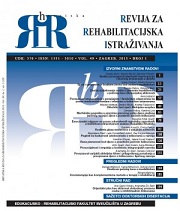Pogledi na budućnost adolescenata s teškoćama u razvoju
Adolescents With Developmental Disabilities and Their Expectations From Future
Author(s): Magdalena Perić, Lejla Osmančević Katkić, Rea Fulgosi MasnjakSubject(s): Education
Published by: Sveučilište u Zagrebu, Edukacijsko-rehabilitacijski fakultet
Keywords: adolescence; developmental disabilities; expectations from future
Summary/Abstract: Adolescent period is a very turbulent period in life of each individual, particularly in lives of those with developmental disabilities. One should make a descision weather to become employed and start independent living, or to continue education. In each case adolescents with developmental disabilities have limited or no choice. In the Republic of Croatia the majority of adolescents with developmental disabilities after finishing secondary school have no possibillity for further education and has to get employed. There are numerous problems in becomming employed, one of the most important are professions which aren’t recognized at the labour market. This investigation is carried out on the sample of 112 secondary school students of both sexes from the town of Varaždin. 56 students had no developmental disabilities and were attending the regular educational program. 56 were students with developmental disabilities who were included either in the regular, or in the special educational program. Students were educated for further professions: helping baker (9), baker (34), carpenter (17), tailor (17), galanterist (8), butcher (1), hairdresser (2), painter (5), car-body mechanic, helping carpenter (12), helping tailor (3). General questionaire (Osmančević Katkić, L. Fulgosi Masnjak, R., 2010) was used for collecting data about participants, while their expectations from future were investigated with Questionaire - Expectations from future (Ajduković, M., Kulenović, A., 1992) and Questionaire- My expectations from future (Urbanc, K., 1999). Collected data were analyzed through descriprive statistical techniques, differences between groups of participants were tested with Chi-square test.
Journal: Hrvatska revija za rehabilitacijska istraživanja
- Issue Year: 49/2013
- Issue No: 1
- Page Range: 108-119
- Page Count: 28
- Language: Croatian

